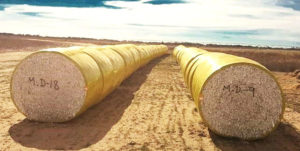
Mark Deleon has been farming in Beckham County, Oklahoma, for 25 years. Pictured from left to right: Addison, Bridget, Amy and Mark Deleon
By Dana Rogge, FSA Public Affairs Specialist
Mark Deleon has been farming in Beckham County, Oklahoma, for 25 years. During this time, he has seen his fair share of ups and downs in the agriculture industry. Farming is a risky business considering the potential for market downturns and natural disasters, but Deleon knows how to mitigate his risks. This is a life he loves – raising cattle and crops.
“I couldn’t have asked for a better life,” Deleon said.
Deleon got his start with help from a USDA Farm Service Agency (FSA) farm ownership loan. A joint loan, made in cooperation with a local bank, allowed Deleon to purchase a farm when he was getting started.
“That really helps young farmers,” he said.
Now that his operation is well-established, he continues to use USDA programs to keep his farm profitable. Deleon rotates peanuts, cotton and potatoes and grazes his cattle on wheat. The 2017 cotton crop was so robust that it will be this spring before Deleon’s cotton will be ginned. While he waits, Deleon utilized FSA’s Marketing Assistance Loan program. These short-term loans provide interim financing at harvest time to meet cash flow needs.
“It has helped tremendously, otherwise I’d have to wait until March,” he said. “Now I have the money to pay farm bills, fertilizer and different costs and not get behind on those.”
To prepare for potential market downturns, Deleon is enrolled in FSA’s Agriculture Risk Coverage (ARC) and Price Loss Coverage (PLC) programs, which can provide a crucial safety-net.
“We are thankful for the safety-net assistance,” he said. “We don’t bank on it, but we’re glad it’s there.”
In addition to marketing and price hurdles, farmers like Deleon have weather uncertainties that can throw a curve-ball. With 150 momma cows, it’s essential that he has adequate pasture and wheat for grazing. To help combat the impacts of Mother Nature, he purchased coverage through FSA’s Noninsured Crop Disaster Assistance Program (NAP) to protect his grazing crops.

Deleon said the programs offered by USDA help farmers and ranchers like him make their operations cash flow, especially when there is a downturn in the farm economy.
NAP provides financial assistance to producers of noninsurable crops when low yields, loss of inventory, or prevented planting occur due to natural disasters. In times of drought, Deleon said NAP helped offset the additional cost he incurred purchasing feed or hay. Likewise, the Livestock Forage Disaster Program (LFP) helped recover from grazing losses.
“It helped producers when we had to sell cows and didn’t have the income the next year,” he said.
Deleon said the programs offered by USDA help farmers and ranchers like him make their operations cash flow, especially when there is a downturn in the farm economy.
“With commodity prices where they are at, there are corn and wheat producers not breaking even,” he said. “These safety-net programs are there to help.”
To learn more about mitigating risks on your farm or ranch, contact your local USDA Service Center. To find your local FSA office, visit http://offices.usda.gov.





